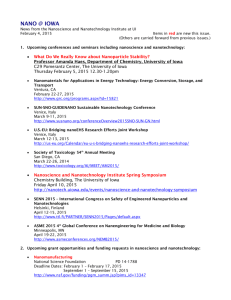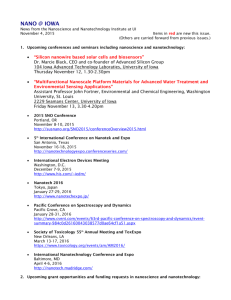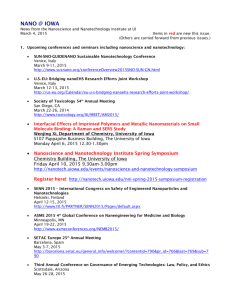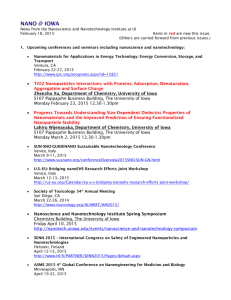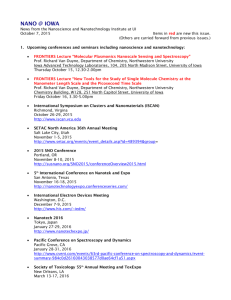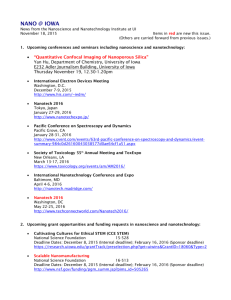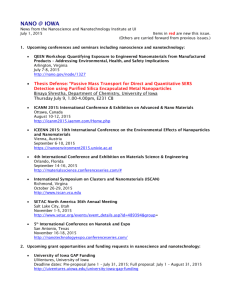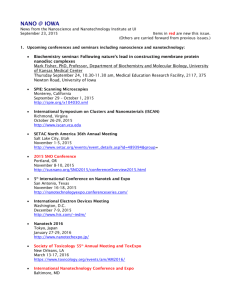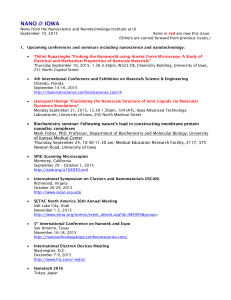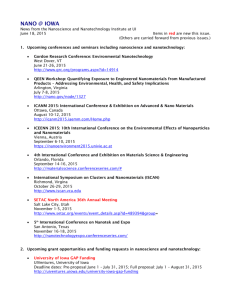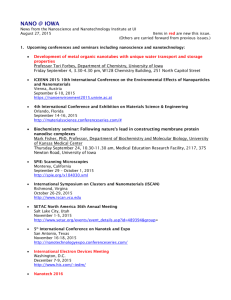October 21, 2015 - Nanoscience and Nanotechnology Institute
advertisement
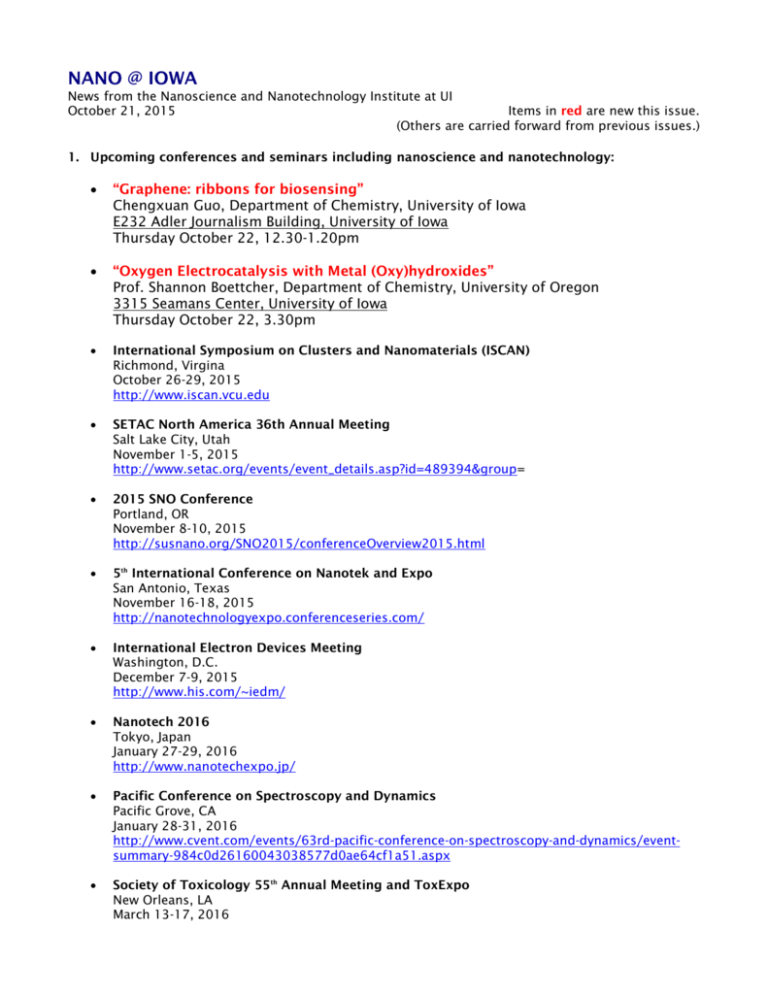
NANO @ IOWA News from the Nanoscience and Nanotechnology Institute at UI October 21, 2015 Items in red are new this issue. (Others are carried forward from previous issues.) 1. Upcoming conferences and seminars including nanoscience and nanotechnology: “Graphene: ribbons for biosensing” Chengxuan Guo, Department of Chemistry, University of Iowa E232 Adler Journalism Building, University of Iowa Thursday October 22, 12.30-1.20pm “Oxygen Electrocatalysis with Metal (Oxy)hydroxides” Prof. Shannon Boettcher, Department of Chemistry, University of Oregon 3315 Seamans Center, University of Iowa Thursday October 22, 3.30pm International Symposium on Clusters and Nanomaterials (ISCAN) Richmond, Virgina October 26-29, 2015 http://www.iscan.vcu.edu SETAC North America 36th Annual Meeting Salt Lake City, Utah November 1-5, 2015 http://www.setac.org/events/event_details.asp?id=489394&group= 2015 SNO Conference Portland, OR November 8-10, 2015 http://susnano.org/SNO2015/conferenceOverview2015.html 5th International Conference on Nanotek and Expo San Antonio, Texas November 16-18, 2015 http://nanotechnologyexpo.conferenceseries.com/ International Electron Devices Meeting Washington, D.C. December 7-9, 2015 http://www.his.com/~iedm/ Nanotech 2016 Tokyo, Japan January 27-29, 2016 http://www.nanotechexpo.jp/ Pacific Conference on Spectroscopy and Dynamics Pacific Grove, CA January 28-31, 2016 http://www.cvent.com/events/63rd-pacific-conference-on-spectroscopy-and-dynamics/eventsummary-984c0d26160043038577d0ae64cf1a51.aspx Society of Toxicology 55th Annual Meeting and ToxExpo New Orleans, LA March 13-17, 2016 https://www.toxicology.org/events/am/AM2016/ International Nanotechnology Conference and Expo Baltimore, MD April 4-6, 2016 http://nanotech.madridge.com/ 2. Upcoming grant opportunities and funding requests in nanoscience and nanotechnology: Polymers National Science Foundation PD 03-1773 Deadline Dates: September 1 – November 2, 2015 http://www.nsf.gov/funding/pgm_summ.jsp?pims_id=5357 Electronics, Photonics and Magnetic Devices National Science Foundation PD 13-1517 Deadline Dates: October 1 – November 2, 2015 http://nsf.gov/funding/pgm_summ.jsp?pims_id=13379 Communications, Circuits, and Sensing-Systems National Science Foundation PD 13-7564 Deadline dates: October 1 – November 2, 2015 http://nsf.gov/funding/pgm_summ.jsp?pims_id=13381 NSF Major Research Instrumentation Program MRI Instrument Acquisition or Development National Science Foundation 15-504 Deadline Dates: October 30, 2015 (Internal deadline); January 13, 2016 (Sponsor deadline) https://research.uiowa.edu/grantTrack/preselection.php?get=uiwins&GrantID=18031&Type=2 Fiscal Year 2016 National Environmental Information Exchange Network Environmental Protection Agency EPA-OEI-16-01 Deadline Date: November 13, 2015 http://www2.epa.gov/exchangenetwork/fiscal-year-2016-national-environmental-informationexchange-network-grant-program Cultivating Cultures for Ethical STEM (CCE STEM) National Science Foundation 15-528 Deadline Dates: December 8, 2015 (Internal deadline); February 16, 2016 (Sponsor deadline) https://research.uiowa.edu/grantTrack/preselection.php?get=uiwins&GrantID=18060&Type=2 OVPRED Internal Funding Initiatives (IFI) University of Iowa Deadline dates: December 15, 2015 and March 22, 2016 http://research.uiowa.edu/researchers/find-funding/internal-funding-initiatives-ifi Designing Materials to Revolutionize and Engineer our Future (DMREF) National Science Foundation 15-608 Deadline dates: January 4 – 19, 2016 http://www.nsf.gov/pubs/2015/nsf15608/nsf15608.htm?WT.mc_id=USNSF_25&WT.mc_ev=clic k 2015 Broad Agency Announcement Engineer Research and Development Center Department of Defense FOA Number: W912HZ-15-BAA-01 Deadline Date: January 31, 2016 http://nano.gov/node/1373 Materials Engineering and Processing National Science Foundation PD 13-8092 Deadline Dates: February 1 – 16, 2016 http://www.nsf.gov/funding/pgm_summ.jsp?pims_id=504950 NIST Measurement Science Research: Material Measurement; Physical Measurement; Engineering; Fire Research; Information Technology; Communications Technology; Neutron Research; Nanoscale Science National Institute of Standards and Technology 2015-NIST-MSE-01 Deadline Date: June 1, 2016 http://www.grants.gov/web/grants/view-opportunity.html?oppId=277027 FY2016 Innovations at the Nexus of Food, Energy, Water Systems (INFEWS) National Science Foundation 15-108 Deadline Date: September 30, 2016 http://www.nsf.gov/pubs/2015/nsf15108/nsf15108.jsp#ref1 Army Research Laboratory BAA for Basic and Applied Scientific Research Department of Defense FOA Number: W911NF-12-R-0011 Deadline Date: March 31, 2017 http://www.arl.army.mil/www/default.cfm?page=8 Image-guided Drug Delivery in Cancer National Institutes for Health (NIH) FOA Number: PA-09-253 Deadline Dates: January 25, May 25, and September 25, annually http://grants.nih.gov/grants/guide/pa-files/PA-09-253.html Exploratory/Developmental Bioengineering Research Grants National Institutes for Health (NIH) FOA Number: PA-12-284 Deadline Dates: January 25, May 25, and September 25, annually http://grants.nih.gov/grants/guide/pa-files/PA-12-284.html Development of Multifunctional Drug and Gene Delivery Systems National Institutes for Health (NIH) FOA Number: PA-10-048 Deadline Dates: February 5, June 5, and October 5, annually http://grants.nih.gov/grants/guide/pa-files/PAR-10-048.html Nanoscience and Nanotechnology in Biology and Medicine National Institutes of Health (NIH) FOA Number: PA-11-148 Deadline Dates: February 5, June 5, October 5, annually http://grants.nih.gov/grants/guide/pa-files/PA-11-148.html Bioengineering Nanotechnology Initiative National Institutes of Health (NIH) FOA Number: PA-10-149 Deadline Dates: April 5, August 5, December 5, annually http://www.grants.gov/web/grants/view-opportunity.html?oppId=53500 Cancer Diagnostic and Therapeautic Agents Enabled by Nanotechnology National Institutes of Health (NIH) FOA Number: PAR-10-286 Deadline Dates: April 5, August 5, December 5, annually http://grants.nih.gov/grants/guide/pa-files/PAR-10-286.html 3. Recent news and updates from NNI: “NanoEHS – defining fundamental science needs: no easy feat when the simple itself is complex” published in Environment Science: Nano University of Iowa and other nationally recognized researchers call for fundamental research in environmental health and safety studies of nanomaterials (NanoEHS). An article entitled “NanoEHS – defining fundamental science needs: no easy feat when the simple itself is complex” was just published in Environmental Science: Nano. The article is the outcome of a National Science Foundation sponsored workshop co-chaired by Vicki Grassian and Amanda Haes held last November in conjunction with the annual meeting of the Sustainable Nanotechnology Organization. The article calls for new systematic, integrated research approaches in NanoEHS, bridging current knowledge gaps, and suggestions of fundamental research areas to further explore the scientific foundation to address NanoEHS needs. For the full article see http://pubs.rsc.org/en/content/articlelanding/2015/en/c5en00112a#!divAbstract “Zeolite and mesoporous silica nanomaterials: greener syntheses, environmental applications and biological toxicity” article makes top 10 An article by Sarah C. Larsen and Sean E. Lehman entitled “Zeolite and mesoporous silica nanomaterials: greener syntheses, environmental applications and biological toxicity” is in the top 10 most accessed Environmental Science: Nano articles in June 2015. The article discusses zeolite and mesoporous silica nanomaterials with emphasis on connections to the environment. Specifically, the topics of greener syntheses, environmental applications and biological toxicity are addressed. For the full article see: http://pubs.rsc.org/en/Content/ArticleLanding/2014/EN/C4EN00031E#!divAbstract 4. Highlights of some new interesting nanoscience and nanotechnology research and articles: Gold nanomembranes resist bending in new experiment The first direct measurement of resistance to bending in a nanoscale membrane has been made by scientists from the University of Chicago, Peking University, the Weizmann Institute of Science and the Department of Energy's (DOE) Argonne National Laboratory. Their research provides researchers with a new, simpler method to measure nanomaterials' resistance to bending and stretching, and opens new possibilities for creating nano-sized objects and machines by controlling and tailoring that resistance. (A nanometer is one-billionth of a meter, about as long as your fingernails grow in one second.) The research team worked with a gold nanomembrane. "It's like a sheet of paper, only ten thousand times thinner," said Heinrich Jaeger of the University of Chicago. "If you slide a piece of paper over the edge of a table, it bends down. The gold nanomembrane behaves the same way, but it's a hundred times stiffer than the paper if scaled to the same thickness—a hundred times more resistant to bending. "Researchers around the world are seeking ways to manipulate ultrathin nanomaterials into stable three-dimensional objects," Jaeger said. "The challenge is how to make a two-dimensional film into a three-dimensional shape when the film is so thin and flexible. It's like nano-origami: how do you get it to hold a stable shape? You need something stiffer than you would expect. It turns out that many nanomembranes may already possess that property." http://phys.org/news/2015-10-gold-nanomembranes-resist.html Nanocarbons clean water without the use of chemicals and transform waste heat into electricity When purifying waste water, chemical reactions are used or it is subjected to elaborate filtering methods to remove salts and heavy metals. Now scientists in Saarbrücken are working on a desalination method which does not require the addition of chemicals and which is highly energy-efficient: in the process known as capacitive de-ionization (CDI), electrodes are used to extract the ions from the water and collect them on the electrodes. The result is clean water and ions which have been enriched on the electrodes. This environmentally friendly process can even be used to generate electricity: emissions such as carbon dioxide are also suited to generating electrical energy when they are dissolved in water as ions. At an international conference in Saarbrücken, more than 110 experts from 20 countries will be exchanging their knowledge from 26th to 28th October in order to further understand and improve the materials and processes which form the basis of CDI. The conference is being organized on the Saarbrücken Campus by the INM – Leibniz Institute for New Materials. The principle of CDI not only serves the purpose of removing unwanted ions from the water. Volker Presser, head of the Energy Materials Group at INM explains, "The generation of electricity can also be the main desired effect, to use emissions from power plants to produce electricity, for example". For this purpose, the emissions merely has to be present in the water as ions. "Carbon dioxide, for example, is very well suited to this purpose" Professor Presser said and added: "It is particularly exciting for us that, thanks to the electrosorption process, we can even convert waste heat into electricity". He said this worked because the electrodes are charged at low temperatures and discharged at higher temperatures. As a result of the temperature increase, the electrical voltage increases so that electrical energy can be recovered directly during discharging. http://phys.org/news/2015-10-nanocarbons-chemicals-electricity.html Scientific breakthrough can lead to cheaper and environmentally friendly solar cells The technique the researchers in Lund are working on is solar cells consisting of a thin film of nanostructured titanium dioxide and a dye that captures solar energy. Today, the best solar cells of this type use dyes containing ruthenium metal - a very rare and expensive element. "Many researchers have tried to replace ruthenium with iron, but without success. All previous attempts have resulted in molecules that convert light energy into heat instead of electrons, which is required for solar cells to generate electricity", says Villy Sundström, Professor of Chemical Physics at Lund University. Researchers at the Chemistry Department in Lund, in collaboration with Uppsala University, have now successfully produced an iron-based dye that is capable of converting light into electrons with nearly 100 per cent efficiency. "The advantage of using iron is that it is a common element in nature. It can provide inexpensive and environmentally friendly applications of solar energy in the future", says Kenneth Wärnmark, Professor of Organic Chemistry at Lund University. http://www.nanotech-now.com/news.cgi?story_id=52391 Anti-clumping strategy for nanoparticles Nanoparticles are ubiquitous in industrial applications ranging from drug delivery and biomedical diagnostics to developing hydrophobic surfaces, lubricant additives and enhanced oil recovery solutions in petroleum fields. For such nanoparticles to be effective, they need to remain well dispersed into the fluid surrounding them. In a study published in EPJ B ("The stability and interfacial properties of functionalized silica nanoparticles dispersed in brine studied by molecular dynamics"), Brazilian physicists identified the conditions that lead to instability of nanoparticles and producing aggregates. This happens when the electric force on their surface no longer balances by the sum of the attractive or repulsive forces between nanoparticles. These findings were recently published by Lucas de Lara from the Centre for Natural and Human Sciences, at the University Federal of ABC (UFABC) in Santo André, SP, Brazil and colleagues. http://www.nanowerk.com/nanotechnology-news/newsid=41621.php About NANO @ IOWA NANO @ IOWA is a biweekly electronic newsletter to inform faculty, staff and students about important news and events in nanoscience and nanotechnology. This newsletter is provided as a service of the Nanoscience and Nanotechnology Institute at UI (NNI). To subscribe to NANO @ IOWA, please send an email to NNI@uiowa.edu with subject line: Subscribe NANO @ IOWA. In the body of the message, type: (your first name) (your last name). To unsubscribe, send an email message to: NNI@uiowa.edu with subject line: Unsubscribe NANO @ IOWA. In the body of the message, type: (your first name) (your last name). If you have news for NANO @ IOWA, please e-mail jenny-nelson@uiowa.edu or call Jenny Nelson at 319-384-3292. http://nanotech.uiowa.edu
